Dfac Military - “Whether it’s breakfast, lunch or dinner, when hunger strikes, Fort Polk’s Patriot Warrior Restaurant, bldg 1162, Glory Loop, and Geronimo Warrior Restaurant, bldg 2382, Alabama Avenue, should be the first lines of defense against an empty stomach,” proclaimed an article posted on the Army’s website in November, urging soldiers to “visit warrior restaurants to experience culinary art at its best.”
Notably, the name change is one of the “significant steps” in the Army’s campaign to get soldiers to actually eat the food served in warrior restaurants, where the ultimate goal is to have stations with various food choices to choose from similar to college dining halls.
Dfac Military
:max_bytes(150000):strip_icc()/GettyImages-526986938-57842c605f9b5831b51014c0.jpg)
While the Army and the Air Force continue to use the normal words for ground and floor, the Navy and Marine Corps train their people to use the word “deck.” For pilots, the ground is the “hard deck,” something Top Gun apparently made a mistake translating.
Yet the Army has a long way to go if they want to make “warrior restaurant” a thing, which, like “fetch,” is not likely to ever happen. At least not as anything other than a joke that even senior Army leaders can’t help but make.
Your Installation Dining Facility (DFAC) offers a rotating menu of several choices of an entrée, soup of the day, starch of the day and vegetable. Those dining in also have the option of a salad bar, pizza, fresh fruit and dessert. There is also a drive through option, so customers in a rush can get their meals and go to work. Carry out meals will be prepared upon customer request over the serving line during regular meal hours.

“We’ve seen the lack of participation at large volumes in the chow halls,” former Army Secretary Ryan McCarthy said last year. “There have been a lot of investments that have been made in the chow halls to also change the menus.”
Rumors. The Army has a bunch of privates living in the barracks where they swap rumors like a knitting circle. Hence, “barracks mill” and “private news network.” For the Navy, their sailors congregate around water fountains referred to as the scuttlebutt. Eventually, “scuttlebutt” became the word for the rumors themselves.
When someone is wearing all their armor and equipment, they’re in “full battle rattle.” For the Army, this means they’re wearing their body armor. While Marines are likely to be wearing the same armor, they’ll grab their “flak.” The flak vest, as seen in most Vietnam war movies, was the predecessor of modern body armor.
Basically, it’s the cafeteria. While the Army and Air Force both officially use the term DFAC, or dining facility, most soldiers and Marines refer to it as the “chow hall.” In the Navy, it’s the galley. All services employ “cooks” in the kitchen. In the Army, the soldiers tasked to help the cooks are KP, kitchen patrol. In the Navy, cooks are assisted by “cranks.”
Paul Szoldra was the Editor in Chief of Task & Purpose from October 2018 until August 2022. Since joining T&P, he has led a talented team of writers, editors, and creators who produce military journalism reaching millions of readers each month. He also founded and edits Duffel Blog, an influential satirical newsletter for the military. Contact the author here.
Who Can Eat at the DFAC? Per Command Policy 12, the DFAC is open to all personnel. This includes all Department of Defense and international military, contractors, and personnel who are at Fort Leavenworth for temporary duty (TDY). Serving our Subsistence-in-Kind (SIK) enlisted Soldiers is paramount and they remain our highest priority. Opening the dining facility to other personnel is discretionary and will not interfere with that priority. SIK Soldiers in uniform have the privilege of moving to the front of the line (pay and serving) during any meal. Authorization to subsist in the dining facility is a privilege and is subject to change by the Commanding General of Fort Leavenworth without prior notification. The current meal cost (cash only at this time) will be charged to all non-SIK customers. The meal costs are prescribed by the Under Secretary of Defense and are subject to change.
There are a lot of ways to get in trouble in the military, and the services have plenty of ways to describe it. While soldiers and airmen typically refer to Article 15s and nonjudicial punishment, Marines may call NJP a “ninja punch.” When Sailors get in big trouble, they can face captain’s mast, an Article 15 from the commander of the ship. Admiral’s mast is one step worse. Serious infractions can result in a “big chicken dinner,” slang for a bad conduct discharge.
Civilians talk about feeling lost when vets start using military lingo, but even vets can get lost when talking to members from other services. Here are 8 things that are common between the branches but with wildly different names:

When a sailor or Marine wants to get out of duty, they “skate” out of it. The Army equivalent is “shamming.” For all the services, shamming or skating by claiming medical issues can get you labeled as a “broke d*ck.”
Confused? So were a bunch of current and former soldiers — and everyone else for that matter — once they learned that the Army was trying to change the “preferred nomenclature” for dining facilities, or DFACs, to “warrior restaurants.”
In the classic 2004 comedy Mean Girls, the character of Regina George orders a friend to stop using a nonsensical word in conversation. “Gretchen, stop trying to make ‘fetch’ happen,” she said. “It’s not going to happen.”
The services can’t even agree on how to grunt. The Army says “Hooah,” when they want to motivate each other, or really to say anything besides, “no.” The Marines prefer “Oorah” while the Navy says “Hooyah.” (The Air Force has no equivalent.)

Still, the Army isn’t alone in trying to serve a chow hall with a side of cringe. The Air Force in 2019 famously touted its healthy food initiative for dining facilities as a way of providing “healthy fueling” for airmen it called “human weapon system[s].”
The military has plenty of names for where service members sit down to eat: Marines usually call them chow halls or mess halls, as do many soldiers. Sailors call it the galley or mess deck. But DFAC (pronounced Dee-Fac) became the preferred shorthand term for most serving at forward operating bases in Iraq and Afghanistan, where lucrative contracts for civilian-run dining facilities allowed “fobbits [to] dine on surf and turf” in “air-conditioned splendor,” as NPR put it.
The name change is part of an Army initiative launched in January 2019 to improve soldiers’ nutrition levels that emphasizes healthy food options. It’s also about saving the service some serious dough considering the Army wastes millions each year producing food that soldiers don’t show up to actually eat.
But the online reaction, from service members and veterans alike to the “warrior restaurant” news was largely negative, not unlike the 1985 “New Coke” debacle in which Coca-Cola debuted a new, better-tasting flavor of the tried-and-true classic that turned out to be universally despised. Many took issue with the Army’s decision to add yet another “warrior” brand to the service, which has a “best warrior” competition, “warrior transition units,” and the “warrior ethos” even embedded in its lexicon alongside its warrior-focused 2003 overhaul of the soldier’s creed.
And Regina’s wise counsel may be needed now more than ever for the United States Army, because just like Gretchen’s ill-fated coinage of “fetch,” the service’s effort to rename its mess halls as “warrior restaurants” is probably not going to happen.
To ensure adequate support to Soldiers, who remain our primary customers, DoD civilians and contractors are limited to the last half hour of the published meal serving period. When the projected head count equals or exceeds 90% seating capacity, a sign will be posted at the entrance, restricting access to Soldiers only.
As Stars & Stripes’ Chad Garland reported, Sgt. Maj. of the Army Michael Grinston plugged the Army’s “transition to the warrior restaurant” in October, and since then the public affairs apparatus has sprung into action to hype facilities where soldiers usually go through a buffet line of mass-produced food options as so-called restaurants for warriors.
By Paul Szoldra | Published Mar 19, 2021 3:34 PM EDT
dfac army, dfas cleveland retirement pay, defense finance and accounting services dfas, dfas pay calendar 2023, military dining facilities, dfac military acronym, dfac military pay system, dfac military food service

